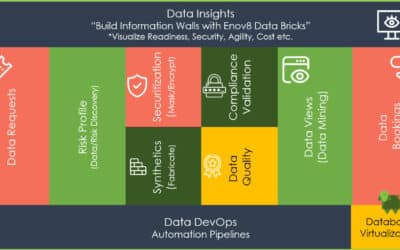
Why CICD & Test Environment Management Goes Hand-in-Hand
DEC, 2022
by Jane Temov.
Jane Temov is an IT Environments Evangelist at Enov8, specializing in IT and Test Environment Management, Test Data Management, Data Security, Disaster Recovery, Release Management, Service Resilience, Configuration Management, DevOps, and Infrastructure/Cloud Migration. Jane is passionate about helping organizations optimize their IT environments for maximum efficiency.
Continuous Integration/Continuous Delivery (CICD) and Test Environment Management are two essential components of a successful software development process. CICD enables teams to deploy new code quickly and efficiently into production, while Test Environment Management ensures that the code is tested in a stable environment before being released. By combining CICD and Test Environment Management, teams can ensure that their code is thoroughly tested before it is deployed, reducing the risk of errors, and improving the quality of their software.
Enov8 IT & Test Environment Manager
*Innovate with Enov8
Streamlining delivery through effective transparency & control of your IT & Test Environments.
In this post, we discuss why its important they be brought together.
What is CI/CD?
CI/CD, or Continuous Integration/Continuous Delivery, is a software development practice that enables developers to quickly and reliably build, test, and deploy code changes. It is a process that automates the steps required to build, test, and deploy software applications. The goal of CI/CD is to reduce the time and effort required to develop, test, and deploy software applications.
CI/CD is a combination of two processes: Continuous Integration (CI) and Continuous Delivery (CD). CI is the process of integrating code changes from multiple developers into a single codebase. This process is automated and typically involves running tests to ensure that the code is working as expected. CD is the process of automating the deployment of code changes to production environments. This process typically involves running tests, building packages, and deploying them to production environments.
CI/CD helps developers reduce the time and effort required to develop, test, and deploy software applications. It also helps ensure that code changes are tested and deployed quickly and reliably. By automating the process of building, testing, and deploying code changes, CI/CD helps developers focus on developing new features and improving existing ones. Additionally, CI/CD helps ensure that code changes are tested and deployed quickly and reliably, reducing the risk of bugs and other issues.
Popular CICD tools include:
- Jenkins
- Team City
- Travis CI
- Circle CI
- Bamboo
- Git Lab CI/CD
- AWS CodePipeline
- Azure Pipelines
What is Test Environment Management?
Test Environment Management is the process of managing and controlling the test environment in order to ensure that it is suitable for testing. It involves setting up, configuring, and maintaining the test environment to ensure that it meets the requirements of the tests. This includes ensuring that all hardware and software components are compatible with each other, that the environment is secure, and that the environment is stable and reliable. Test Environment Management also involves monitoring the environment to ensure that it remains suitable for testing. This includes monitoring for changes in the environment, such as new software or hardware components being added, or changes in the configuration of the environment. Test Environment Management also involves ensuring that the environment is properly maintained and updated, and that any changes to the environment are properly documented.
Enov8 provides a comprehensive suite of tools for Test Environment Management, including automated provisioning, configuration management, and monitoring. These tools help to ensure that the test environment is properly managed and maintained, and that any changes to the environment are properly documented.
Why would CICD Leads reject Test Environment Management?
Some CICD engineers may reject Test Environment Management because it can be time consuming and costly to maintain, as well as difficult to keep up with the changing needs of the environment. Additionally, some CICD engineers may find that Test Environment Management is not necessary for their particular use case, or that it is too complex for their workflow.
Why does CICD need good Test Environment Management?
Test Environment Management (TEM) is an essential tool for CICD engineers as it helps them to ensure that their applications and services are running in a consistent, reliable, and secure environment. TEM provides the ability to quickly create and manage test environments that are tailored to the specific needs of the application or service being tested. This allows CICD engineers to quickly identify any issues with the code or environment before it goes into production. Additionally, TEM can help reduce costs associated with creating and maintaining test environments, as well as provide visibility into the performance of those environments. Ultimately, embracing Test Environment Management can help CICD engineers save time and money while ensuring their applications and services are running smoothly.
CICD needs good test environments to ensure that any changes made to a codebase are tested in a real–world environment before they are released into production. This helps to reduce the risk of introducing bugs or other issues into a live system. Good test environments also allow developers to quickly and easily test their code against different versions of software, different operating systems, and different hardware configurations. This allows them to identify any potential issues before they are released into production.
What are consequences of CICD not promoting good Test Environment Management?
If CICD does not promote good Test Environment Management, it can have serious consequences. Poorly managed test environments can lead to unreliable results, as the environment may not accurately reflect the production environment. This can lead to bugs and defects being released into production, resulting in customer dissatisfaction and lost revenue. Additionally, without proper management of test environments, teams may struggle to keep up with the pace of development as they will be unable to quickly spin up new environments or replicate existing ones. This can lead to delays in releases and a decrease in productivity. Finally, without proper Test Environment Management, teams may find it difficult to track changes and ensure that all tests are properly executed and documented.
Key outcomes of failed CICD & TEM communication include:
1 Poor code quality: Without proper testing, the codebase can become riddled with bugs and errors, leading to poor performance and reliability.
2 Increased costs: Without proper testing, the cost of fixing bugs and errors can quickly add up.
3 Security vulnerabilities: Without proper testing, malicious actors can exploit security vulnerabilities in the codebase.
4 Unreliable releases: Without proper testing, releases can be unreliable and cause disruption to users or customers.
5 Loss of customer trust: Poorly tested code can lead to customer dissatisfaction and a loss of trust in the product or service being provided.
The top 10 things a Test Environment Manager should do in support of CICD teams
1 Ensure that test environments are available and configured correctly for CICD teams to use.
2 Monitor and maintain the health of test environments to ensure they are up-to-date and running smoothly.
3 Automate the provisioning and configuration of test environments to reduce manual effort and improve efficiency.
4 Establish best practices for managing test environments, such as version control, security, and backup procedures.
5 Develop processes for quickly spinning up new test environments when needed by CICD teams.
6 Track usage of test environments to identify any potential bottlenecks or performance issues that need addressing.
7 Work with CICD teams to define requirements for each environment, such as hardware specifications, software versions, etc., in order to ensure compatibility with their applications or services under development or testing.
8 Regularly review existing test environment configurations to ensure they are up to date with the latest software versions, security patches, etc., in order to prevent any potential issues from arising during testing or deployment activities.
9 Collaborate with CICD teams on developing strategies for optimizing resource usage across multiple test environments in order to maximize cost savings while still meeting their needs effectively.
10 Provide support and troubleshooting assistance when needed by CICD teams in order to resolve any issues encountered while using the test environment(s).

CICD & TEM In Conclusion
In conclusion, CICD and Test Environment Management go together when it comes to successful software development. CICD helps teams quickly and reliably build, test, and deploy code changes, while Test Environment Management ensures that the code is tested in a stable environment before it is released. By combining these two processes, teams can ensure that their code is thoroughly tested before it is deployed, reducing the risk of errors and improving the quality of their software. Test Environment Managers play an important role in this process by ensuring that test environments are available and configured correctly for CICD teams to use, monitoring, and maintaining the health of test environments, automating the provisioning and configuration of test environments, and providing support and troubleshooting assistance when needed.
If you’d like to know more about how Enov8 Environment & Release Manager can help achieve this goal, then please reach out.
Relevant Articles
8 DevOps Anti-Patterns to Avoid
It’s the normal case with software buzzwords that people focus so much on what something is that they forget what it is not. DevOps is no exception. To truly embrace DevOps and cherish what it is, it’s important to comprehend what it isn’t. A plethora...
An Introduction to Application Rationalization
In today's fast-paced digital landscape, organizations often find themselves grappling with a sprawling array of applications. While these applications are crucial for various business operations, the lack of a structured approach to managing them can lead to...
What Makes a Great Test Data Management Tool
What Makes a Great Test Data Management Tool? In today's fast-paced IT landscape, having a robust Test Data Management (TDM) tool is crucial for ensuring quality, compliance, and efficiency in software development and testing. At Enov8, we pride ourselves on providing...
The Top Application Portfolio Management Tools
Managing an application portfolio is essential for organizations aiming to optimize their IT operations, reduce costs, and enhance overall efficiency. Application Portfolio Management (APM) tools are designed to help organizations achieve these goals by providing a...
What Is a Test Data Manager?
Testing is a critical aspect of software development, and it requires the use of appropriate test data to ensure that the software performs optimally. Test data management (TDM) is the process of creating, storing, and managing test data to ensure its quality,...
Sprint Scheduling: A Guide to Your Agile Calendar
Agile sprints can be a powerful, productive and collaborative event if managed properly. However, when neglected or set up incorrectly they risk becoming chaotic and inefficient. Crafting an effective schedule for your sprint is essential to ensure the success of your...










